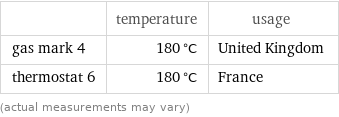Input interpretation

heptadecanoyl chloride | boiling point
Result

176 °C (degrees Celsius) (measured at 533.2 Pa)
Unit conversions

449.2 K (kelvins)

348.8 °F (degrees Fahrenheit)

808.5 °R (degrees Rankine)

140.8 °Ré (degrees Réaumur)

99.9 °Rø (degrees Rømer)
Comparisons as temperature

56.78 °C below autoignition temperature of book paper in Ray Bradbury's famous novel (451 °F)

(40 to 70) °C below autoignition temperature of paper (218 to 246 °C)

49 °C above hottest temperature of a Concorde nose tip (127 °C)
Corresponding quantities

Thermodynamic energy E from E = kT: | 39 meV (millielectronvolts)

Blackbody energy flux Φ from Φ = σT^4: | 2308 W/m^2 (watts per square meter)

Approximate luminous exitance from a planar blackbody radiator perpendicular to its surface: | 1.1×10^-11 lx (lux)
Nearest corresponding gas marks

| temperature | usage gas mark 4 | 180 °C | United Kingdom thermostat 6 | 180 °C | France (actual measurements may vary)